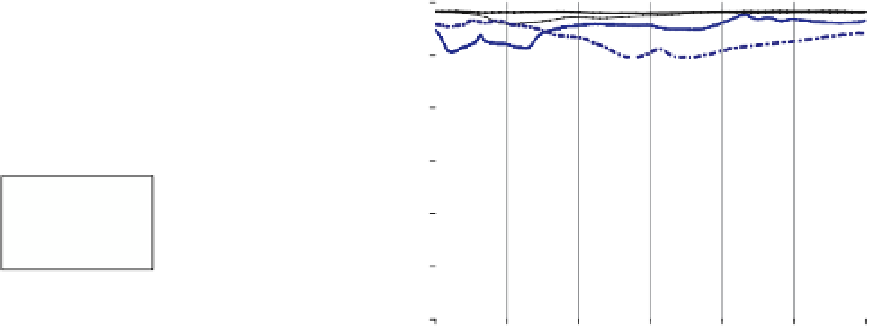Geography Reference
In-Depth Information
1.00
1.0
1.00
0.9
0.99
Very dark grayish brown silty loam
Green rye grass
Conifer
Dry grass
Galvanized steel metal
0.8
0.99
0.98
0.7
Tap water
Distilled water
Sea water
Sea foam
0.98
0.6
0.97
0.5
0.97
0.96
0.4
8
9
10
11
12
13
14
8
9
10
11
12
13
14
Wavelength (
μ
m)
Wavelength (
μ
m)
(a)
(b)
Figure 5.6
Emissivity in the 8-14
m TIR region for (a) water and foam, and (b) other relevant materials. Note different scales for
the x-axes (''Very dark grayish brown silty loam'' [
85P3707
], green rye grass [
grass
], conifer [
conifers
], dry grass [
drygrass
], galvanized
steel [
0525UUUSTLb
], tap water [
TAPWATER
], sea water [
SEAWATER
], and sea foam [
FOAM
] from the ASTER Spectral Library,
Version 2.0 [
Baldridge
et al
., 2009
]; distilled water [
WATER2_W
] from the MODIS Emissivity Library, 2010).
μ
of rivers. As described by Lillesand et al. (2008), for most
natural materials that are opaque to thermal radiation,
Kirchhoff's Law describes how an object's emissivity and
absorptivity are equal. Due to the conservation of energy,
this can be written as:
5.3.3 UsingPlanck'sLawtodetermine
temperature fromTIRobservations
The radiant energy incident on a surface (e.g., sunlight)
is termed its irradiance, while the radiant energy exciting
the surface is its radiant emittance. The radiation emitted
by an object is often assumed to be
Lambertian
, or emit-
ting equally at all angles, although in practice water can
be roughened by wind and waves and behave in a non-
Lambertian manner. The radiant emittance is usually not
measured across the whole hemisphere, but only from a
particular direction and solid angle (measured in steradi-
ans, sr). For an assumed Lambertian surface, the radiation
leaving the surface is assumed to be uniformly distributed
across the hemisphere above the surface (which subtends
2
π
sr). When measured at a particular wavelength, the
units of spectral radiant emittance are Wm
−
2
ε
(
λ
)
=
1-
ρ
(
λ
)
(5.1)
ε
λ
where
) is the emissivity of the material at a wave-
length
λ
,and
ρ
(
λ
) is the reflectivity of the material. This
relationship describes why water, for example, has a very
low reflectivity across all wavelengths, and a correspond-
ingly high emissivity. Equation (5.1) can also be used to
determine an object's emissivity if its reflectivity in the
TIR is known.
Good sources of reflectivity and emissivity data are
spectral libraries, such as the MODIS Emissivity Library
(2010) and the ASTER Reflectivity Library (Baldridge
et al., 2009). Spectral libraries have the advantage of
being measured under controlled conditions. Although
the spectral libraries cannot cover all variations in emis-
sivity described above, standard spectra for distilled water
are usually suitable for the accuracy requirements of many
applications which require T
r
, including the TIR remote
sensing of rivers. Emissivity and reflectivity spectra from
a library also generally cover a range in wavelengths, with
measurements at fine spectral intervals (e.g., 1 nm), and,
if needed, the spectral data can be mathematically con-
volved to match the specific spectral characteristics of the
data acquired for a given application.
(
m
−
1
.
Planck's Law describes the non-linear relationship of
the total radiant emittance from a blackbody, at a partic-
ular wavelength, to its temperature. When expressed per
unit wavelength, Planck's Law in simplified form (Mather
2004) is as follows:
μ
c
1
W
(
λ
,T)
=
(5.2)
λ
5
(
e
c
2
/
λ
T
−
1)
where
W
(
, T) is the total spectral radiant emittance (i.e.
not per unit of solid angle) at a particular temperature per
unit area of emitting surface at wavelength (
λ
) in meters
(Wm
−
2
m
−
1
), T is the object's temperature inKelvin,
c
1
is
3
λ
10
−
16
W
m
−
2
,and
c
2
is 1
10
−
2
mK.To
.
×
·
.
×
7242
4388



















































Search WWH ::

Custom Search